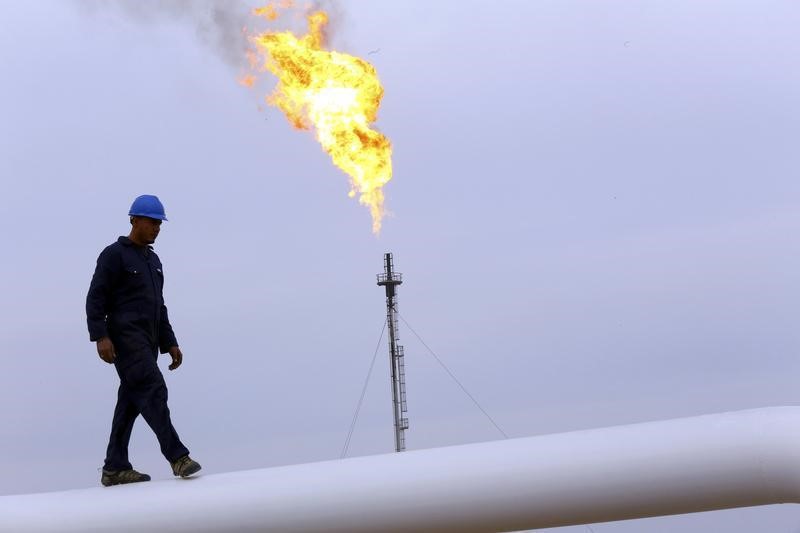Commodities
Oil: Up 2nd week on Mideast troubles, but downside risks growing too


© Reuters.
Investing.com – The scare projected to the oil trade by the Israel-Hamas war pushed crude prices up for a second straight week, though the absence of any real disruption to barrels coming out of the Middle East is also giving rise to intraday volatility.
Both US crude and its UK peer Brent jumped almost 2% at one point on Friday before giving all that back and settling the day in the negative. Gains in recent sessions, however, kept the two benchmarks in the black for the week.
New York-traded West Texas Intermediate, or , crude for delivery in December settled Friday’s trade down 29 cents, or 0.3%, at $88.08 per barrel. December WTI earlier hit a session high of $89.85. For the week, the US crude benchmark rose 2%, adding to the prior week’s gain of around 6%.
London-traded crude for the most-active December contract finished Wednesday’s session at $92.16, down 22 cents, or 0.2%. For the week, the global crude benchmark showed a gain of 1.4% after the prior week’s gain of 7,.5%.
Many on Wall Street seem to think crude prices should be higher anyway due the relative proximity of the showdown in Gaza to some of the biggest oil producers, such as Saudi Arabia, the United Arab Emirates, Iraq and Kuwait.
While Israel and Palestine themselves barely register in the global oil trade, the Strait of Hormuz straddling them is a key chokepoint for the movement of crude, where a fifth of all oil passes through its waters.
Also, the almost daily saber-rattling against Israel by avowed Hamas supporter and fifth largest oil producer Iran — and concerns of reprisals against Tehran by the Israelis and their main ally, the United States — has added to concerns that something untoward might happen soon.
“The potential for the war between Israel and Gaza to become more widespread is making traders nervous and adding a significant risk premium to oil prices at a time when the market is already extremely tight,” said Ed Moya, analyst at online trading platform OANDA.
“Traders are wary of weekend events triggering a shock price move on the open which likely explains the moves we’re seeing today,” Moya said, referencing Friday’s highs that came after mid-week explosion at a Gaza hospital that reportedly killed hundreds of people.
Yet, some oil traders see the conflict for what it is — a major political event that has not shown any demonstrable risk thus far to the crude trade.
“My heart goes out to every life that’s been lost in this senseless war, and I really mean that,” said John Kilduff, partner at New York energy hedge fund Again Capital. “But to assign a daily war premium to oil because of this is pure BS.”
The weekly rise in oil prices wasn’t without merit.
US stockpile drop, Fed boost vs Venezuela sanctions easing
US stockpiles of , and all showed notable reductions last week in a weekly inventory update issued by the Energy Information Administration on Wednesday.
Federal Reserve Chair Jerome Powell added to the upside momentum in not just oil but most commodities on Thursday with comments that seemed to reinforce the central bank’s hesitancy in pushing interest rates any higher than where they already were.
But there were also downsides to the sentiment in oil this week, with the United States granting Venezuela a six-month waiver from the sanctions imposed on the South American’s oil trade, after the Maduro government there agreed in principle to hold free and fair elections in 2024.
The deal is not expected to quickly expand Venezuela’s oil output but could boost profits by returning some foreign companies to its oilfields and providing its crude to a wider set of cash-paying customers, experts said.
“The general reaction in the market to the Venezuela deal is “oh, it’s nothing in the grand scheme of oil’,” said Kilduff of Again Capital. “But at least, it’s a real incentive for the oil industry in terms of production versus the imaginative impact thus far from the Israel-Hamas war.”
(Peter and Ambar Warrick contributed to this article)
Commodities
Oil prices rise; U.S. crude inventories plunge, Russia-Ukraine truce eyed
Commodities
India’s Reliance to stop buying Venezuelan oil over US tariffs, sources say
Commodities
Oil prices climb on Venezuela supply worries

 Forex3 years ago
Forex3 years agoForex Today: the dollar is gaining strength amid gloomy sentiment at the start of the Fed’s week

 Forex3 years ago
Forex3 years agoUnbiased review of Pocket Option broker

 Forex3 years ago
Forex3 years agoDollar to pound sterling exchange rate today: Pound plummeted to its lowest since 1985

 Forex3 years ago
Forex3 years agoHow is the Australian dollar doing today?

 Cryptocurrency3 years ago
Cryptocurrency3 years agoWhat happened in the crypto market – current events today

 World3 years ago
World3 years agoWhy are modern video games an art form?

 Commodities3 years ago
Commodities3 years agoCopper continues to fall in price on expectations of lower demand in China

 Economy3 years ago
Economy3 years agoCrude oil tankers double in price due to EU anti-Russian sanctions



























